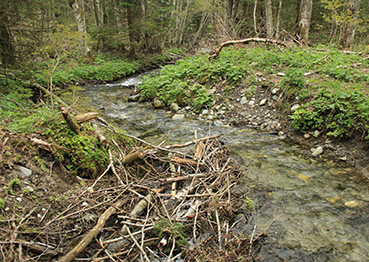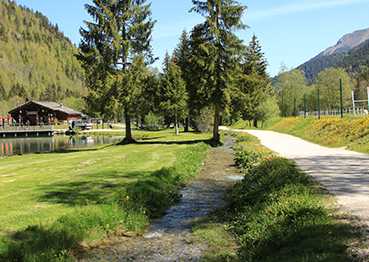

Context
The Duchère stream is a right bank tributary of the Bonnant, the main watercourse draining the Val Montjoie. Located upstream of the tourist resort of Les Contamines Montjoie, it originates from the conjunction of several springs on the Dôme de Miage and Mont Blanc massif. These springs end up forming a stream that flows to the bottom of the valley, through remnants of alluvial forests, mountain meadows and, for several decades, a leisure centre for both summer and winter tourist activities. The various developments inherent to this leisure centre have simplified the initial course of the Duchère as well as the morphology of its bed and banks. Some adjacent wetlands have also been altered. Over a large stretch, the Duchère is bordered by the Tour du Mont-Blanc route which, in the summer months, is used daily by several thousand hikers, putting a great deal of pressure on this small river.
In contrast to the Bonnant, which has all the characteristics of a mountain torrent, in particular significant variations in flow and a sizable volume of sediment transport, the Duchère has only slight variations in flow and almost insignificant sediment. These characteristics make it a potentially ideal refuge area for fish fauna during floods in the Bonnant. In addition, the stream also has areas potentially favourable for river trout spawning.
Before implication of the EVA research group in the execution of the project, the restoration of the Duchère was the subject of a preliminary study carried out through a bachelor's thesis of the HEPIA Nature Management program.
Objectives
Restoring the Duchère aims to increase its carrying capacity, particularly for fish fauna, and more particularly to reinforce its functions as a potential refuge and breeding ground. To do this, it is necessary to reinforce the structure of the bed and banks, to encourage the development of semi-aquatic vegetation and to improve the connection with the Bonnant (the structure of the confluence is not ideal today).
It is also a question of maintaining or even improving the attractiveness of this fundamental landscape structure for hikers and users of the leisure centre, but at the same time limiting the pressure and disturbance.
Finally, where possible, some of the piped secondary tributaries will be reopened and the adjoining wetlands revitalised, by increasing the hydromorphic character of their substrate.
The SM3A has therefore requested the implementation of a restoration project from the EVA group, as well as a complete action plan for the execution of the works.


Project partner(s)
Project leader - team
Pierre-André Frossard
(HEPIA),
Millo Pénault-Ravaillé
(HEPIA)
